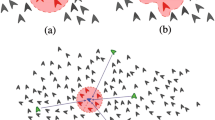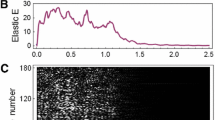Abstract.
We formulate a Lagrangian (individual-based) model to investigate the spacing of individuals in a social aggregate (e.g., swarm, flock, school, or herd). Mutual interactions of swarm members have been expressed as the gradient of a potential function in previous theoretical studies. In this specific case, one can construct a Lyapunov function, whose minima correspond to stable stationary states of the system. The range of repulsion (r) and attraction (a) must satisfy r<a for cohesive groups (i.e., short range repulsion and long range attraction). We show quantitatively how repulsion must dominate attraction (Rr d+1>cAa d+1 where R, A are magnitudes, c is a constant of order 1, and d is the space dimension) to avoid collapse of the group to a tight cluster. We also verify the existence of a well-spaced locally stable state, having a characteristic individual distance. When the number of individuals in a group increases, a dichotomy occurs between swarms in which individual distance is preserved versus those in which the physical size of the group is maintained at the expense of greater crowding.
Similar content being viewed by others
References
Aoki, I., Inagaki, T.: Photographic observations on the behaviour of Japanese anchovie. Engraulis japonica at night in the sea. Mar. Ecol. Prog. Ser. 43, 213–221 (1988)
Beecham, J.A., Farnsworth, K.D.: Animal group forces resulting from predator avoidance and competition minimization. J. Theor. Biol. 198, 533–548 (1999)
Breder, C.M.: Structure of a fish school. Bull. Amer. Mus. Nat. Hist. 98, 1–27 (1951)
Breder, C.M.: Equations descriptive of fish schools and other animal aggregations. Ecology 35, 361–370 (1954)
Caraco, T., Bayham, M.C.: Some geometric aspects of house sparrow flocks. Animal Behaviour 30, 990–996 (1982)
Conder, P.J.: Individual distance. Ibis 91, 649–655 (1949)
Crespi, B.J.: The evolution of social behaviour in micro-organisms. Trends in Ecol. Evol. 16(4), 178–183 (2001)
Cross, M.C., Hohenberg, P.C.: Pattern formation outside of equilibrium. Rev. Mod. Phys. 65, 851–1112 (1993)
Emlen, J.T.: Flocking behaviour in birds. Auk 69, 160–170 (1952)
Flierl, G., Grunbaum, D., Levin, S., Olson, D.: From individual to aggregations: the interplay between behaviour and physics. J. Theor. Biol. 196, 397–454 (1999)
Gardner, C.S., Radin, C.: The infinite-volume ground state of the Lennard-Jones potential. J. Stat. Phys. 20, 719–724 (1979)
Graves, J.: Photographic method for measuring spacing and density within pelagic fish schools at sea. Fish. Bull. 75, 230–234 (1976)
Grunbaum, D., Okubo, A.: Modelling social animal aggregation. In: S. Levin (ed.), Frontiers in Mathematical Biology, Springer N.Y. 1994, pp. 296–325
Gueron, S., Levin, S.A., Rubenstein, D.I.: The dynamics of herds: From individual to aggregations. J. Theor. Biol. 182, 85–98 (1996)
Haken, H.: Synergetics; An Introduction: Nonequilibrium Phase Transitions and Self-Organization in Physics, Chemistry, and Biology, New York, 3rd edition 1983
Hamilton, W.D.: Geometry for the selfish herd. J. Theor. Biol. 31, 295–311 (1971)
Holmes, E.E., Lewis, M.A., Banks, J.E., Veit, R.R.: PDE in ecology: spatial interactions and population dynamics. Ecology 75(1), 17–29 (1994)
Huth, A., Wissel, C.: The simulation of movement of fish schools. J. Theor. biol. 156, 365–385 (1992)
Keller, E.F., Segel, L.A.: Initiation of slime-mold aggregation viewed as an instability. J. Theor. Biol. 26, 399–415 (1970)
Krause, J., Tegeder, R.W.: The mechanism of aggregation behaviour in fish shoals: individuals minimize approach time to neighbors. Anim. Behav. 48, 353–359 (1994)
Lee, C.T., Hoopes, M.F., Diehl, J., Gilliland, W., Huxel, G., Leaverand, E.V., McCann, K., Umbanhowar, J., Mogilner, A.: Non-local concepts and models in biology. J. Theor. Biol. 210, 201–219 (2001)
Miller, R.S., Stephen, W.J.D.: Spatial relationships in flocks of sandhill cranes. Ecology 47(2), 323–327 (1966)
Misund, O.A.: Sonar observations of schooling herring: school dimensions swimming behaviour and avoidance of vessel and purse seine Rapp. P.-v. Reun. Cons. int. Explor. Mer 189, 135–146 (1990)
Misund, O.A.: Dynamics of moving masses: variability in packing density shape and size among herring sprat and saithe schools. ICES. J. mar. Sci. 50, 145–160 (1993)
Mogilner, A., Edelstein-Keshet, L.: A non-local model for a swarm. J. Math. Biol. 38, 534–570 (1999)
Newlands, N.: PhD Thesis: Shoaling dynamics and abundance estimation: Atlantic Bluefin Tuna (Thunnus thynnus), Fisheries Center UBC, Vancouver BC Canada, 2002
Niwa, H.-S.: Self-organizing dynamic model of fish schooling. J. Theor. Biol. 171, 123–136 (1994)
Niwa, H-S.: Newtonian dynamical approach to fish schooling. J. Theor. Biol. 181, 47–63 (1996)
Okubo, A.: Diffusion and Ecological Problems: Mathematical Models. Springer Verlag, New York, 1980
Okubo, A.: Dynamical aspects of animal grouping:swarms, schools, flocks, and herds. Adv. Biophys. 22, 1–94 (1986)
Parr, A.E.: A contribution to the theoretical analysis of the schooling behaviour of fishes. Occasional Papers of the Bingham Oceanographic Collection 1, 1–32 (1927)
Parrish, J., Edelstein-Keshet, L.: Complexity, pattern, and evolutionary trade-offs in animal aggregation. Science 284, 99–101 (1999)
Parrish, J.K., Hamner, W.M., Prewitt, C.T.: From individuals to aggregations: Unifying properties, global framework, and the holy grails of congregation, In: J.K. Parrish, W.M. Hamner (eds.), Animal Groups in Three Dimensions 1997 Cambridge University Press pp. 1–13 Cambridge U.K.
Radin, C.: The ground state for soft discs. J. Stat. Phys 26, 365–373 (1981)
Sakai, S.: A model for group structure and its behavior. Biophysics Japan 13, 82–90 (1973)
Sinclair, A.R.E.: The African buffalo: a study of resource limitation of populations, University of Chicago Press, Chicago 1977
Suzuki, R., Sakai, S.: Movement of a group of animals. Biophysics Japan 13, 281–282 (1973)
Tegeder, R.W., Krause, J.: Density dependence and numerosity in fright stimulated aggregation behaviour in shoaling fish. Phil. Trans. R. Soc. Lond. B 350, 381–390 (1995)
Turchin, P.: Beyond simple diffusion: models of not-so-simple movement in animals and cells. Comments on Theor Biol 1, 65–83 (1989)
Uvarov, B.P.: Locusts and Grasshoppers, Imperial Bureau of Entomology. London, 1928
Vabo, R., Nottestad, L.: An individual based model of fish school reactions: predicting antipredator behaviour as observed in nature. Fisheries Oceanography 6(3), 155–171 (1997)
Viscido, S.V., Miller, M., Wethey, D.S.: The response of a selfish herd to an attack from outside the group perimeter. J. Theor. Biol. 208, 315–328 (2001)
Viscido, S.V., Wethey, D.S.: Quantitative analysis of fiddler crab flock movement: evidence for ‘selfish herd’ behaviour. Animal Behaviour 63(4), 735–741 (2002)
Warburton, K., Lazarus, J.: Tendency-distance models of social cohesion in animal groups. J. Theor. Biol. 150, 473–488 (1991)
Author information
Authors and Affiliations
Corresponding author
Rights and permissions
About this article
Cite this article
Mogilner, A., Edelstein-Keshet, L., Bent, L. et al. Mutual interactions, potentials, and individual distance in a social aggregation. J. Math. Biol. 47, 353–389 (2003). https://doi.org/10.1007/s00285-003-0209-7
Received:
Revised:
Published:
Issue Date:
DOI: https://doi.org/10.1007/s00285-003-0209-7




